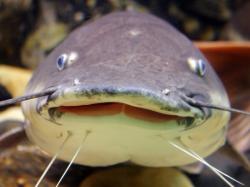Producing Better Catfish The Hybrid Way
November 15, 2013 | 1 min to read

The catfish once ranked pretty far down among fish species as a lowly bottom feeder, but that was when it could only be caught in the wild. With the birth of freshwater catfish farming in the 1960s, the catfish has made a big splash, netting the number-one spot in the U.S. aquaculture industry.
However, in recent years, U.S. catfish producers have been struggling to keep their heads above water, avoiding the waves of a slow economy, high feed costs, and fish imports from foreign countries. Sales of catfish products were down to about $341 million in 2012 from $423 million in 2011, and acreage has declined in the major catfish producing states—Alabama, Arkansas, Louisiana, and Mississippi.
To help farmers, Agricultural Research Service scientists in the Warmwater Aquaculture Research Unit (WARU) and their Mississippi State University (MSU) colleagues at the Thad Cochran National Warmwater Aquaculture Center in Stoneville, Mississippi, are looking at breeding, nutrition, genetics, and management practices to produce a better catfish. For decades, it’s been known that hybrid catfish—a cross of the fast-growing channel catfish with its close relative, the slower growing and larger blue catfish—generally have better growth, higher survival, and better meat yield than either channel or blue catfish. But hybrids have been difficult to produce in large quantities. That’s changing.
To read the rest of the story, please go to: USDA Agricultural Research Magazine
